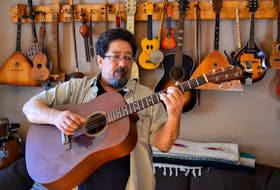
Today is the day that 75-year-old William Pryse-Phillips begins his fourth pilgrimage.
Not to Mecca. Not to Lourdes. But on the road towards the tomb of
St. James in Santiago de Compostela, a small town tucked away in the northwestern corner of Spain.
St. James apparently died a nasty death by beheading in Jerusalem in AD 44. And for some reason, his body was put in a boat of stone and set adrift off the coast of Israel where it overcame currents and wind to wash ashore in Finisterre, or Land’s End, in northwestern Spain.
Then, instead of burying the body at its landfall, it was moved a few klicks inland to Santiago and interred. It is there, under the main altar in the cathedral in the Santiago town square, where St. James lies today.
Since the Middle Ages, pilgrims of all nationalities and religions have been following the way of
St. James (El Camino de Santiago). There was a period of maybe a thousand years when pilgrimages along El Camino sort of fell out of fashion.
But in the 1960s, a few priests decided to revive the tradition. And revive it they did. Now more than 100,000 pilgrims complete the journey to the tomb of St. James each year earning certificates, or compostelas, which are supposed to reduce the amount of time a person spends in purgatory.
But not just anyone can roll into town claiming to have walked hundreds of kilometres to reach the city where St. James is buried in a gold coffin. A pilgrim must show proof in the form of a pilgrim’s passport or credential stamped by various hotels, restaurants or police stations along the route. In order to be a true pilgrim, one must walk 100 km or bicycle 200 km ending at Santiago de Compostela.
Because the first pilgrims traditionally set out from their own homes all over Europe, there is no one set route. There are, however, several popular and well-documented routes, especially from France and within Spain.
Pryse-Phillips, a British-born neurologist who has been practising in St. John’s since 1972, has done several of them, all well over the minimum 100 km.
Born in 1937, the semi-retired physician first did a pilgrimage to Santiago in 2005 using the French route. Although I have lived in the south of France, I was so shocked when Pryse-Phillips described his route and I had to consult a map to confirm what I was hearing was true.
I have taken trains across France and Spain but this man in his 60s and now 70s, albeit fit and healthy, walked across two large European countries crossing three mountain ranges on his way. I was flabbergasted.
“The first trip was from St. Jean Pied de Port in France over the Pyrenees to Pamplona, then turn West and go on to a number of small towns and through such cities as Burgos, Leon and Astorga to get to Santiago.
“(Although) over 95 per cent of this route is in northern Spain; (it) is known as the Camino Frances.” says Pryse-Phillips, who repeated this route in 2007, with his son, Sam, ending the 800 km walk after 32 days.
It is a strenuous venture, he explains, that can see you hiking alone for hundreds of kilometres.
“I started with a 1,500 foot climb from St. Jean Pied de Port into Roncesvalles. It takes three hours to walk from France into Spain. … There is no official sign (or border crossing) but there’s a barbed wire fence with a gate.”
On these first days, Pryse-Phillips walked between 30 and 40 km per day, seeing no one except six curly-tusked wild boar in the forest.
“That meeting caused me to think four things: first, to shout; second, that I couldn’t climb a tree wearing a backpack; next, that I had two walking sticks I could use to poke them; and finally, that God will protect pilgrims.”
The third trip started at Vezelay, France. He walked almost 900 kilometres diagonally southwest across France down to St Jean Pied de Port.
“I walked the first 12 days alone, but a friend joined me for the next seven days after which I had a few more days by myself and then walked with my daughter Amy for the last 10 days.”
It was on this third Camino that the soles of the Vasque boots on Pryse-Phillips’s feet fell apart.
“I’d walked 300 miles in 18 days” before the boots gave out, says Pryse-Phillips. “I gave them to a cordonnier (French shoemaker) who said: ‘C’est impossible, monsieur.’”
But Pryse-Phillips could not part with the boots that had taken him “across two Spanish Caminos and half of the French Camino.” So, he sent them home to St. John’s where Kevin Wright at the Modern Shoe Hospital ordered in new Vibram soles, and these are the boots that are en route to Paris via Montreal today.
They will then go by train to Vezelay to make their fourth pilgrimage to the tomb of St. James in Compostela, using the same route as the third. And again, Pryse-Phillips’s son, Sam, will join him for 10 days.
When Pryse-Phillips hits the trail, a plastic pouch containing his map and trail notes for the day will be hanging around his neck for easy access. And on his back a 25-pound backpack carrying his spare clothes, a pair of light shoes to wear in the evenings, a French-English dictionary, and two litres of water in a CamelBak bladder bag.
Off his backpack hangs a clamshell, the symbol of St. James — you know, coquilles Saint-Jacques? This is the same shell he used on his other three Caminos. In the Middle Ages, a clamshell picked up on the beach was used as proof that pilgrims had reached their destination.
As for accommodation, Pryse-Phillips takes care of everything himself, carrying a European cell phone to book a couple of days in advance. Many pilgrims seek help with accommodation and some even have their bags transported from one hostel to the next. But that seems a bit like cheating to me.
Pryse-Phillips carries everything he needs on his being. And although he has stayed in pilgrims’ hostels (albergues) where you are limited to one night and you have to be up and out by 8 a.m., he now prefers to sleep in a chambre d’hôte (B&B) for about 40-50 euros a night, breakfast in.
“The first time I stayed in an albergue (5-10 euros per night), there were 159 other people, most of whom snored,” says Pryse-Phillips, who also likes the Parador Hotel chain owned by the Spanish government that offers half price for those over 65 and half price for pilgrims. Sounds like a deal.
“One hotel owner in Bénévent l’Abbaye (left) the front door unlocked,” says Pryse-Phillips. “He left a note inside giving directions to a room made up for me on a day that the place was actually closed and which was, except for me, totally uninhabited.”
There are as many reasons to walk the Camino as there are pilgrims on the route, explains Pryse-Phillips. The first time he attended noon mass at the Cathedral of Santiago and heard his place of origin read out by the priest, his eyes misted.
“Uno peregrino de Terra Nova,” are the words he heard when he completed the journey in 2005.
“The first time I did the Camino, I got half my time off purgatory,” he says with a laugh. “The question is, the next time did I get the other half off or only half off what was left?”
That is perhaps a question only answered once you reach the other side.
Here are several questions Pryse-Phillips was able to answer.
Where do you get a pilgrim’s passport?
You can pick up a pilgrim passport at Vezelay or at St Jean Pied du Port … but I got mine from the U.K. twice; and from the Canadian society once.
How much will El Camino cost?
Minimum cost in France would be €5 per night in a hostel; and €30-€60 Euro for a CH or hotel. Add in €20-€30 per day for food and wine. Also factor in the cost of the airfare to Paris, and the cost of rail ticket from Paris to your starting point.
Which guide do you use?
I use a guide in French, by M. and Mme. Chassain, with all possible details and maps, sold at the bargain price of about 25 pounds. To have it is essential because of the detailed data, advice and instructions for the route that it offers. The maps here are to scale and the instructions are very detailed, sometimes itemizing course changes every 100 yards or so.
Is the trail busy?
Not really, except in the summer. Because of that I tend to go in the spring or fall. But of course the closer you get to the northwest corner of Spain, the busier the trail becomes.
What are the most essential items to bring?
A good guide book. (For the French route, Pryse-Phillips favours a guide book by Monique et Jean Charles Chassain called “Itinéraire du Pèlerin de St. Jacques: Voie Historique de Vézelay.”) The best hiking boots you can buy. I estimate that
40 per cent of the route is on paved roads, while the rest is on country paths or tracks through woods, forests, vineyards and open farmland.
Susan Flanagan is a journalist who recently watched “The Way” produced and directed by Emilio Estevez and starring his father Martin Sheen. The movie tells the story of a man who ends up hiking El Camino trail from southern France to northwestern Spain in honour of his son. Susan hopes to one day complete the Portuguese Camino starting in Oporto, the town of origin of Newman’s Port and walk the 227 km to Santiago. She can be reached at [email protected].








